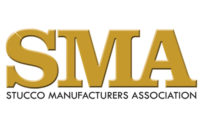Energy requirements are pressing designers to find ways to incorporate insulation behind all claddings. This can be a challenge, but the plastering industry has done it for years and offers a variety of systems or assemblies.
EIFS
Exterior insulated finish systems were specifically invented to emulate stucco and add the benefit of continuous insulation. EIFS should be the first choice for most commercial projects and all projects that use masonry as the substrate. EIFS on framed walls are required to have a drainage system and most meet current rainscreen requirements. Caveats include: Avoid putting foam plastic on ceilings and adhere to that manufacturer’s system requirements.
One-coat Stucco
One-coat stucco systems are another CI stucco that has proven to work well. These are proprietary systems that require having and following an evaluation report for code approval. Most have tongue-and-groove foam sheathing over the framing. The water-resistant barrier is typically behind the grooved foam. Most of these systems have been tested for drainage and meet the drainage code requirement for Moist (A) and Marine (C) climate zones. These systems are most often found in the residential market. A lath is applied over the rigid foam and attached to framing members. Caveats: There are some limitations for one-coat stucco and they are listed in the evaluation report. Follow the manufacturer’s recommendations for product substitutions and installation.
History of Stucco and Foam
Cement plaster is generic when applied in three coats to framing. Even the Stucco Manufacturers Association recommends EIFS on masonry walls that require insulated stucco. For framed walls, cement plaster (stucco) is possible. One of the Portland Cement Association’s manuals (fifth edition) states: “Portland cement plaster bonds tenaciously to most insulation, such as polyurethane, polystyrene, and cork. Each of these materials, although basically water resistant, possesses sufficient surface irregularities to allow mechanical keying of plaster to the insulation material.”
This has also been noted by the SMA and explains why the industry prefers cement plaster to be applied to the insulation substrate, and to place the water-resistant barrier behind the rigid insulation. The industry recommends an approved lath over the insulation but allows the cement to bond to the insulation.
EPS (expanded polystyrene) is the preferred insulation for CI three-coat cement plaster on framed walls. The industry also suggests designers use no more than 2-inch thick foam. XPS (extruded polystyrene) has the same coefficient of expansion, but the SMA tends to see more cracking when this foam is used. This is likely because XPS foam is more dense, rigid and does not give as easily when it expands and pushes against the shaft of the fastener, resulting in outward bowing that can result in hairline cracking on cement that is not fully cured. This is easily solved by using a crack suppression membrane (base and mesh) over the brown coat.
Polyisocyanurate is another popular foam sheathing. Many designers want to place a water-resistant barrier over this foam sheathing. If the density of the foam is sufficient to hang a nail-flange window frame over the foam sheathing, similar to wood-base and gypsum sheathing, the SMA sees no reason the water-resistant barrier could not be over this type of sheathing. The issue is cement bonding to rigid foam and tearing holes in the water-resistant barrier. Consider it is also best to provide a straight line path for water drainage. This includes flashings in conjunction with the water-resistant barrier to allow easy flow without having to navigate around angles and pockets.
Mineral wool is the newest insulation material, and testing is ongoing to see how it can work with cement plasters. The fire-resistance benefit is a no-brainer, as mineral wool and cement plaster are both non-combustible. Together, they could provide improved fire-rated assemblies. The concern is water intrusion and these tests are focused on that issue. So far, the results are extremely encouraging that cement plater and mineral wool be fire and water-resistant.
Another newcomer is the insulated sheathing board or panel. These are similar to structural insulated panels. Many have no framing members and are engineered to be strong enough on their own. The issue is that for lath to support cement plaster, it is to be attached to the framing and not just the wood panel skin. Some have felt that adding more fasteners will solve the issue. This is not advisable; installers should use large wafer-head or disc-type wood screws to ensure the lath is securely attached to the structural panel.
Contractors should verify anything they see when it appears out of the ordinary; check with manufacturers, associations and supporting documents for their response. Do not be afraid of insulation with stucco—closely follow manufacturer’s instructions or verify with an authoritative source your plan on attachment and detailing. Remember, documentation is the key to protection.





Report Abusive Comment